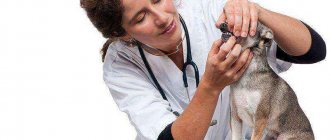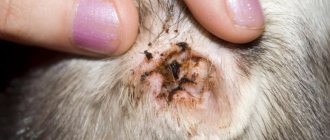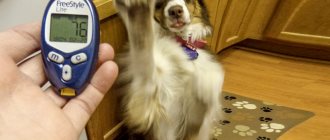Unfortunately, the dog cannot tell the owner about his poor health, so he has to carefully monitor the state of her health. Most often, dogs suffer from pain in the abdominal area. An experienced owner should know what can provoke them and how to understand the cause of their occurrence.
Every breed of dog is susceptible to stomach pain.
How does a dog perceive pain?
Gastrointestinal diseases in dogs are quite common. They can be either congenital or acquired.
Pets, like people, can suffer from abdominal pain. However, dogs are quite patient animals and endure pain steadfastly, often without even showing the owner that something is bothering them. For quite a long period of time, a dog that is in pain may behave as if nothing had happened.
Only if the pain becomes unbearable can the owner notice that something is wrong with the pet, since signs of pathology are clearly visible. As a rule, if the owner decides to show his four-legged friend to the veterinarian, he enters the clinic at the moment when the pathology has become subacute or chronic.
Important! If the situation has reached its peak, even an hour of delay can cost the life of your beloved animal.
To avoid this, the owner must carefully monitor the behavior of his pet and, at the first suspicion, contact a veterinary clinic, where a veterinarian can provide timely assistance.
Main reasons
If we think from a dog’s point of view, it’s hard to think of a better place to sleep than on his beloved owner. This behavior is dictated by instincts. Dogs are pack animals, and when settling down for the night, from time immemorial they preferred to stay as close to each other as possible. It's warmer and safer.
Having become domesticated, some did not abandon their wild habits. They may be forced to sleep on their owner by the cold or a feeling of insecurity. Observations have shown that the dog more actively seeks the company of its owner if some “irritant” appears in the house: a child, noisy guests or a new pet.
The company of the owner calms the dog. She feels especially good when she not only warms up and is under his protection, but also hears the beating of his heart. Moreover, once on a person, she seems to return to the time when she was a puppy, and people often took her in their arms to caress, calm and protect her.
It is also believed that dogs are a kind of “doctors”. They can not only diagnose the disease at an early stage, but also begin to “treat” it, acting like a biological heating pad. Therefore, if a pet obsessively lies down in the area of the liver, stomach, or climbs directly to the head, this is a reason to go to the doctor.
How to tell if your dog has stomach pain
Colic in dogs can be determined by the following signs:
- The dog lies on its stomach, constantly turning around in attempts to find a pain-free position.
- The condition may be accompanied by vomiting, constipation or diarrhea.
- The dog does not allow you to touch his stomach, while it is swollen and often growls.
- The color and consistency of stool changes and may also contain mucus or blood.
- The pet refuses to eat, which can lead to rapid weight loss.
Having detected at least one of the listed symptoms, the owner needs to measure the animal’s body temperature. It can either go up or down.
Important! It should be remembered that in a painful condition, the work of not only one organ is disrupted, so it is necessary to palpate the stomach, liver, intestines and pancreas to determine the most painful area.
Another alarming symptom that indicates a number of diseases is a change in the smell from the pet’s mouth.
You can tell by your pet's behavior that he is suffering from discomfort.
Oral diseases
Tartar, early tooth loss, and bad breath are also common diseases among Toy Terriers.
If you notice that your pet's teeth are falling out, you should immediately contact a specialist, as this can lead to serious consequences.
For example, bleeding gums, pain, strong uneven load on the remaining teeth can lead to their abrasion and malocclusion.
There are several reasons for tooth loss. The most popular of them are the formation of tartar, soft food, the constant consumption of which can lead to caries and tooth decay.
Lack of stress on the jaw can also cause tooth loss in dogs kept in confined spaces. Regular teeth brushing can be a solution to the problem .
There are many reasons for bad breath. If you feel that your pet's mouth smells bad, you need to carefully examine the oral cavity.
Bad breath can be accompanied by a change in your pet's teeth. Oral trauma and tartar can also cause bad breath.
If an examination of the oral cavity does not yield results, then your pet has digestive problems.
If the bad breath is accompanied by vomiting or diarrhea, then most likely your pet has been poisoned.
In any case, it is best to contact a specialist. He will determine the reason why your pet has bad breath.
In order to exclude infectious diseases, it is necessary to give your pet all necessary vaccinations in a timely manner.
Habits and behavior during abdominal pain
The animal can endure mild pain, but when it reaches its peak, the dog begins to whine, howl, and also show anxiety. During the next spasm, she looks back at her stomach, but at the same time does not allow her to touch it. Sometimes owners may notice that the dog has a hot stomach.
The pet’s behavior completely changes, it reacts poorly to stimuli, refuses to follow usual commands, does not express any particular desire to go outside, and also refuses its favorite games.
On a note! Often, a usually affectionate and friendly dog begins to show aggression not only towards strangers, but also towards members of the household.
The discomfort experienced by the pet can also affect the musculoskeletal system. So, he may begin to limp, take unnatural poses, hunch over, raise the back of his body while walking and try not to make sudden movements.
If an animal is suffering from severe pain, it often tries to hide in a dark and secluded place, lie on its stomach on a cold surface, and after it warms up, change its location.
The owner needs to know the symptoms of diseases that cause abdominal pain in a pet.
At my feet
It is not uncommon for dogs (just like cats) to sleep at people’s feet. And most of us regard this position as the animal's utmost devotion. However, this is not entirely true. Indeed, your dog is very devoted to you, but by this he also wants to say that in your sleep you toss and turn too much. Its position at the feet is explained by the fact that if you make any sudden movement in your sleep, the dog will be able to quickly jump out of bed so that you do not crush it.
Why might your dog have stomach pain?
Pain can occur due to a number of reasons. The owner should know the most common ones and study the signs characteristic of each case in order to promptly determine when their four-legged friend begins to get sick.
Poisoning
An inquisitive dog always tries to explore the territory and, having discovered something interesting on the ground, taste it. It is this habit that often leads to poisoning.
There are several types of poisoning:
- food - toxins enter the body when the dog eats spoiled or any other food;
- respiratory – the substance enters through the nose;
- contact - occurs through direct contact with the skin.
Food poisoning is more common than others. It is characterized by symptoms such as:
- refusal of food;
- high level of salivation;
- stomach upset;
- vomit;
- body temperature does not rise above +37 degrees.
Helminth infection
The presence of parasites in the intestines can cause stomach pain. Signs of helminth infection are as follows:
- dull coat and regular shedding;
- skin rash;
- reduction or complete refusal of food and fun games;
- discharge from the eyes;
- gastrointestinal disorders.
Eating problems
Poor nutrition can cause abdominal cramps in your dog. Most often, the cause of the disease is feeding the animal from a common table.
Abdominal pain caused by poor dog diet
Symptoms that help identify this condition are as follows:
- gas formation;
- abdominal pain.
Important! Small breeds, such as Yorkies, are more likely to suffer from illnesses that include abdominal pain.
Injury and foreign object penetration
Ingestion of foreign objects that get stuck in the digestive organs is a problem that almost all dog owners face. The cause of discomfort is injury caused by a foreign object.
Symptoms:
- refusal to eat;
- depressed state of the pet;
- labored breathing;
- high body temperature;
- vomit;
- painful sensations during bowel movements;
- the presence of blood in the stool.
Note! If it is not possible to remove a foreign object by inducing vomiting, then there is only one option left - surgery.
Infections
There are several infectious diseases that cause abdominal pain in dogs. This:
- colibacillosis;
- salmonellosis;
- carnivore plague;
- parvovirus enteritis.
Important! Salmonellosis is especially dangerous because it is transmitted from a sick dog to humans.
A dog can “catch” an infectious disease either through airborne droplets or through direct contact with other relatives.
Pancreatitis
The disease affects the pet's pancreas. The disease is provoked by poor-quality nutrition, diabetes, parasites and other diseases.
Symptoms:
- sharp abdominal pain;
- frequent vomiting;
- high pulse and temperature;
- diarrhea.
Inflammations of the genitourinary system
The disease is accompanied by involuntary and frequent urination and thirst.
Cancerous tumors
Oncological pathologies arise from a cell that has been subject to genetic mutations.
Important! A representative of any breed can get any disease.
What to do if your dog has a stomach ache
Only a veterinarian can make a diagnosis.
If a pet is suffering from abdominal pain, it must be taken to a veterinary clinic, where a specialist will conduct a thorough examination, identify the cause of the disease and prescribe effective treatment. If there is no opportunity to go to a veterinary clinic, you must try to alleviate the animal’s condition. To do this you can:
- Give a light abdominal massage, but only if the pet does not show aggression.
- Give an analgesic.
- In case of poisoning, give enterosorbent.
- If the dog is healthy, but has not relieved himself for several days, you can give him a remedy for constipation.
Preventive measures
The condition of a dog’s digestive system largely depends on the attentive and responsible attitude of the owner towards his four-legged pet. You can avoid many problems, including those with the animal’s gastrointestinal tract, if you choose the right diet.
You should not give your dog sweet food.
- The dog should be fed only high-quality and fresh food . Do not give the animal prohibited foods (sweets, fatty meats and foods high in salt and spices).
- When walking your dog, you need to make sure that he does not pick up food or foreign objects on the street.
- Don't forget to give your pet anti-worm medication every six months .
- Do not allow the dog to injure the abdominal area , because damage to internal organs can even cause the death of the animal.
What can you give your dog for stomach pain?
Almost every pet owner has times when he wonders how to help if a puppy has a tummy ache, or how to make life easier for an adult dog.
Note! Any medications can be given strictly as prescribed by a doctor. But before contacting a specialist, you should alleviate your pet’s condition.
If the dog suffers from constipation, you can pour a spoonful of vegetable oil into its mouth, but this method can only be used if the internal organs are not affected. The oil should be poured carefully, it should not get into the nose or ear.
To alleviate the condition of your four-legged friend, you can give him No-shpu or activated carbon. These medications will improve the dog’s condition, but will not eliminate the cause of the problem.
Important! It is permissible to give medications a few hours before going to the veterinary clinic, otherwise they will dull the symptoms. If an animal has diarrhea and vomiting, it should not be allowed to eat until examined by a veterinarian.
You should only give medications to your four-legged friend after consulting a veterinarian.
Why can't you pet puppies on the head and ears?
Adult dogs love to have their ears and head petted, but veterinarians do not recommend this procedure with puppies. This is especially true for those breeds whose ears must stand upright according to the standards, and for show animals.
While stroking your puppy's head, you can damage the still fragile ear cartilage.
Despite the fact that you really want to pat the puppy on the head, the owner should restrain his desires. Touching this part of the body is not recommended for physiological reasons. The ears are the puppy's weakest point due to their soft cartilage. Due to constant contact, their shape may be damaged. The ear cartilage in puppies strengthens by 5-6 months, which coincides with the period of replacement of milk teeth with permanent ones. After this, you can safely touch your pet’s ears.
How is the diagnosis carried out?
After providing first aid, the pet should be taken to the veterinary clinic. The doctor will examine the animal, perform palpation, prescribe stool, urine and blood tests, and, if necessary, conduct an ultrasound and x-ray. Taking into account the results obtained, treatment will be prescribed, thanks to which it will be possible to neutralize the dog’s abdominal cramps and eliminate the cause if the situation is not advanced.
Important! At the appointment, the veterinarian must be told approximately when the pain began and what its nature is.










